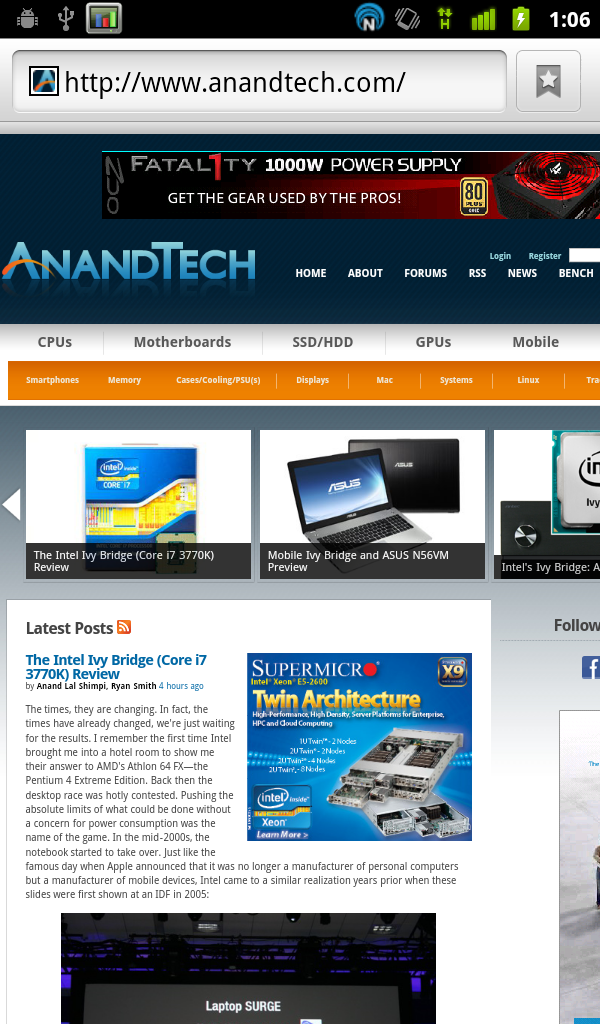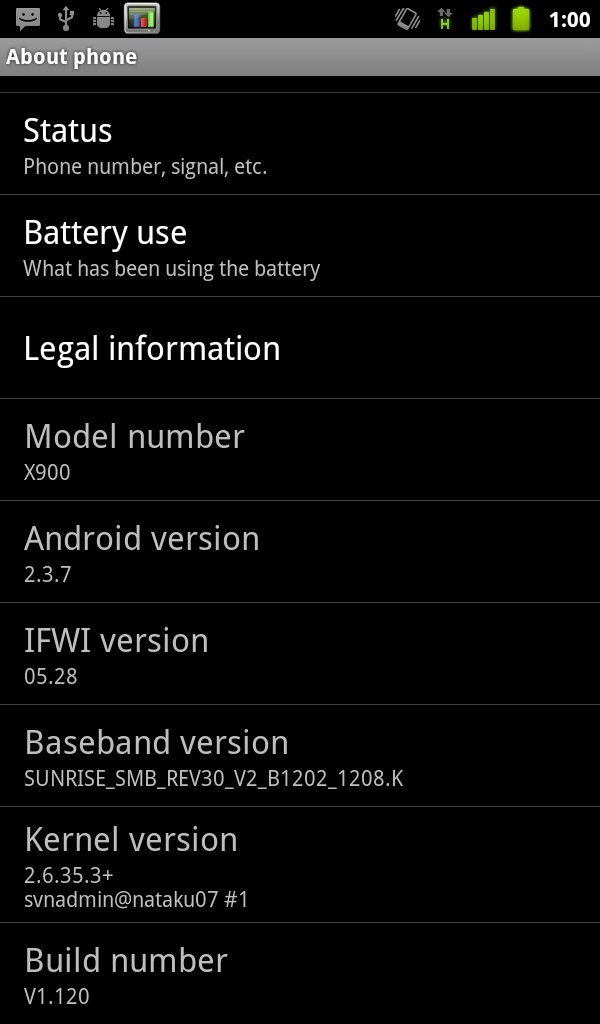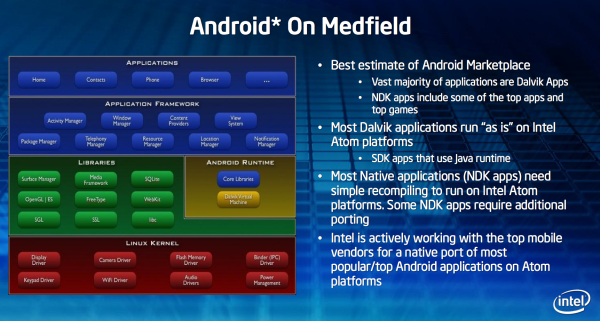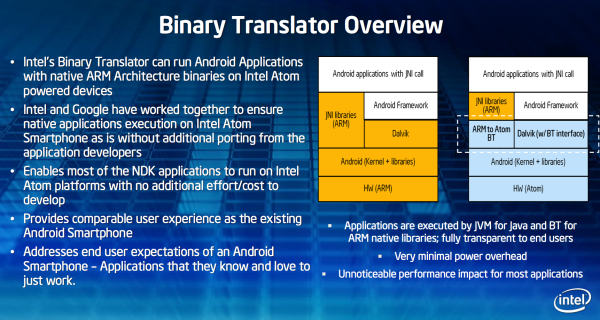Lava Xolo X900 Review - The First Intel Medfield Phone
by Brian Klug on April 25, 2012 6:00 AM ESTAndroid on x86 and Binary Translation
So the other major and obvious piece of the puzzle is what changes were required to make Android and all of its applications run on x86. Android itself has already been built for x86 before, and again we’ve seen and played with it running all the way back at IDF 2010. That part of the puzzle is relatively understood, but the devil again is in the edge cases. Among the things that need massaging for x86 are the Dalvik VM, x86 JIT, NDK, and JavaScript engine.
Android itself is actually an ideal platform for Intel to target, as the vast majority of Android applications in the Play Store run atop the Dalvik VM and use the Android Framework (75–80% are commonly cited numbers, depending on how you’re counting). The rest either are Dalvik VM applications that run and use JNI (Java Native Interface) libraries that are built for ARM only, or NDK (Native Development Kit) applications. So where does Intel’s binary translation secret sauce fit into all this? Simply put, Intel’s binary translation is the mitigation for both libraries and NDK applications that haven’t yet been ported to x86, and allows the device to expose itself as supporting two application binary interfaces (ABIs), both x86 and ARMv5, in fact this is easy enough to see upon superficial inspection of build.prop:
ro.product.cpu.abi=x86 ... ro.product.cpu.abi2=armeabi
In the case of Dalvik applications, developers don’t need to do anything. Thankfully again this is the vast majority of Android applications you encounter on a daily basis - they just work, given that Intel has made Dalvik work with x86 and spit out the right machine code.
NDK applications are also easy enough to mitigate - the developer simply needs to recompile the NDK project, which supports ARMv5 (‘armeabi’), ARMv7 (‘armeabi-v7a’), and x86 (‘x86’). Building for x86 will deliver code that’s tailored (unsurprisingly) exactly to the Saltwell CPU feature set, or more explicitly what you’d get by running GCC with the compiler flags “-march=i686 -msse3 -mstackrealign -mfpmath=sse” - this is all outlined in the CPU-ARCH-ABIS.html document as part of the NDK documentation. The resulting APK can be packaged as a “fat binary” with machine code for all three platforms, and upon install only the proper one is unpacked and installed.
The remaining two cases are where binary translation come in. In the case of applications that haven’t been rebuilt with the NDK to target x86, the binary translator magic kicks in and translates the armeabi version into x86. The same applies for applications that request some JNI libraries that are currently ARM only.
Intel outlines this in a number of slides which have made their way online, and the process is virtually completely transparent to end users and Dalvik applications. The x86 compatible Dalvik VM is a part of the OS, as are the ARM to Atom BT phase for JNI libraries. ARM native NDK apps on the other hand are translated by Intel in the cloud, validated against Intel's Android x86 emulator and pushed to the Play Store. The point is the bulk of binary translation happens away from the device itself and running on much faster Xeons in the cloud. As binary translation requires more cycles than natively running the code, which in turn consumes additional power, this was the only route for Intel to ensure that Atom would remain power efficient (and high performance) even on non-native NDK apps. Update: Intel has clarified and informed us there is no cloud aspect to binary translation, it is 100% done on the device for ARM NDK applications.
It's still unclear just how long this process takes after a developer has uploaded a non-x86 NDK app to the Play Store, or what happens if the process fails to validate for whatever reason (Does Intel get in touch with the developer? Is the app forever excluded?). Intel is being unusually vague about how all of this works unfortunately.
The combination of all of these efforts should result in over 90% of the apps in the Play Store working right away. What about in our experience? We discuss that next.
Software: Nearly Flawless
The X900 that I was sent came running Android 2.3.7, which is the latest version on the 2.3 branch. Xolo intends to deliver an Android 4.0.3 update later, and Intel internally has its own 4.0.x image stable and ready to go, which we’ve seen running on the FFRD a bunch before. It’s a bit odd to see things going this way when 4.0.x is clearly already ready, but no doubt some logistical issues with carrier support are the final hurdle. I’m eager to check out Intel’s 4.0.x port and intend to update when that happens.


Xolo and Intel have basically left things entirely stock with the X900. The notifications shade has one minor positive change - inclusion of the power controls, and Swype is bundled in addition to the stock Android 2.3 keyboard. There’s one Xolo Care support application preloaded, and basically nothing else. I can honestly say this is the least preloaded junk I’ve ever seen on a non-Nexus device.


So the next logical step is talking about how well Android and its apps work on x86 in practice, and the answer is unsurprisingly that almost everything is perfect. I installed about 80% of all the Android applications I’ve ever installed on any Android phone (thanks to the new Google Play ‘All’ tab) and nearly all of them worked perfectly. In fact, all of my daily driver applications work flawlessly: Twitter for Android, Baconreader, Speedtest.net, Barcode Scanner, Astro, Dropbox, Facebook, GPS Test Plus, GPS Status, Instagram, IP Cam Viewer, GTA III, Remote Desktop, Swiftkey X, and WiFi Analyzer all work perfectly.


That said there are indeed a few edge cases where things don’t seem to be perfect. For one, Flash 11 isn’t available for the X900, and throws an error in the market. The device does come preloaded running Flash 10.3 however, which gets the job done although is a bit dated. In addition, although Netflix would download, the installer would throw a ‘package file invalid’ error upon install. This is what leads me to think there’s some APK interception in the cloud and perhaps translation up there, and Netflix DRM not translating, but that’s speculation. Other than this, everything else I encountered works flawlessly, I wager your average Android user wouldn't be able to tell that this is running on a completely different architecture.












106 Comments
View All Comments
Spunjji - Thursday, April 26, 2012 - link
...so, suddenly it becomes more than mere opinion when you say the opposite? You have to admit you're on shaky ground with that line of argument."Could benefit from being thinner" isn't quite the same as "too thick". I suspect you mean the former?
UltraTech79 - Thursday, April 26, 2012 - link
Its not an opinion when its true. Phones should stay below 1CM thickness, and even 1CM is pretty beefy. Many people will not consider it due to this and not having a real huge advantage anywhere else.When all else is roughly the same, comfort and aesthetics decide a buy.
phoenix_rizzen - Friday, April 27, 2012 - link
1 cm is *way* too thin for anyone with "normal"-sized hands.Compare the aesthetics of holding/using a cordless phone, an office phone, a corded-phone, basically any phone handset other than a cell phone to a cell phone. Which feels more comfortable in your hand to speak into for more than 3 seconds? The one that fits nicely in the palm of your hand, that nicely curves with the natural lines of your hand (aka everything other than a cell)? Or the one with sharp edges, barely 1 cm thick, that requires you to use the muscles in the sides of your hands to grip, leading to cramping if you actually try to, you know, talk, on the phone?
Today's cell phones are too thin, and battery life is suffering for it.
fm123 - Friday, April 27, 2012 - link
Definitely an opinion. If someone wants a keyboard it's going to be over 1 cm. There are people that put their phone in cases and the result is way over 1 cm. The Otterbox Defender is somewhat popular, and the phone becomes almost 3/4 inch thick.FrederickL - Thursday, April 26, 2012 - link
On the general issue of "phone-thinness" rather than this phone in particular no doubt the same people who want the mobile equivalent of an anorexic catwalk model will then start howling about the battery life in their super-thin phone where there is scarcely room for a battery at all, let alone one with decent capacity. Perhaps we should be discussing the fact that some customers' contradictory "want my cake and eat it" demands indicate that the topic should be that some of the customers are too thick rather than the phones.
mrtanner70 - Wednesday, April 25, 2012 - link
I find the "a bigger battery is all we need" argument rather weird in the context of the thickness. It's not like Intel has not already considered this trade off. It's lighter than I expected though.The trouble with reviews like this (and this is not a criticism) is that SOC price is not considered, nor that fact that the mobile industry really would rather Intel, and its monopolistic/margin desires, stay away. Benchmarks (unless paradigm breaking) are not going to change that.
So far, I do not believe Intel has a single true design win, they paid for them all.
menting - Wednesday, April 25, 2012 - link
profit margins for ARM and Intel as a whole company, if this page can be believed, are similarhttp://ycharts.com/companies/ARMH/profit_margin#se...
menting - Wednesday, April 25, 2012 - link
we dont know what that phone will cost in the US, but for a phone that costs $420 with that performance???? ARM will be pissing in their pants right now if it had the performance of A15 on that phone.duploxxx - Wednesday, April 25, 2012 - link
Knowing that it can't keep up against already existing platforms introduced a while ago it is a failure. Don't see any reason why to buy this mobile phone, it doesn't have any added value against any other major competitor.not on price/power/performance.
so it is doomed before it is even released.
lets see what the tablet brings, but it doesn't look good at all. It all starts with the Atom which has never proven to be a good arch.....
A5 - Wednesday, April 25, 2012 - link
For a first attempt (Moorestown was always going to fail, so I don't count it :P) it really isn't that bad. It pretty handily beats the A9-class SoCs from last year while being somewhat competitive with the S4 running ICS. I'm curious to see if the Medfield ICS build gets better performance.I don't know how much Medfield phones will cost, but if it comes over here as a $420 off-contract device, that places it pretty firmly in the mid-range, where it would certainly be pretty competitive with the A9 devices that will be down there.